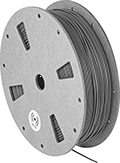Dremel 3D Printer Filaments

Build parts and prototypes from these filaments using Dremel fused filament fabrication (FFF) 3D printers. An RFID tag on the spool communicates with your printer, automatically adjusting it to the correct temperature and print speed for the filament material and notifying you when the filament is running out.
PETG is more moisture resistant than ECO-ABS, making it a great choice for printing parts for use in humid or wet environments. Generally, PETG’s other properties fall somewhere between those of PLA and ECO-ABS. It’s more flexible and durable than PLA, but less so than ECO-ABS. It’s harder to print than PLA because it requires a heated printer bed, but easier to print than ECO-ABS. PETG filaments should be kept in a sealed container with a desiccant.
Tensile strength is the best measure of a filament's overall strength. Similar to the stress applied on a rope during a game of tug-of-war, it's the amount of pulling force a material can handle before breaking. A higher rating means a stronger filament. A tensile strength of 5,000 psi and above is considered good; 12,000 psi and above is excellent.
Maximum exposure temperature is the point at which a printed part will begin to deform. Above this temperature, your printed parts will start to lose structural integrity.
Spool | ||||||||||||
|---|---|---|---|---|---|---|---|---|---|---|---|---|
| Manufacturer Model No. | Dia., mm | Printing Temp. | For Printer Bed Temp. | Tensile Strength | Max. Exposure Temp. | For Min. Nozzle Opening Dia., mm | Dia., mm | Dp., mm | Wt., g | Color | Each | |
PETG Plastic | ||||||||||||
| PETG-TRA-01 | 1.75 | 240° to 260° C 464° to 500° F | 80° C 175° F | 7,250 psi (Good) | 84° C 183° F | 0.2 | 181 | 55 | 750 | Clear | 0000000 | 000000 |


























